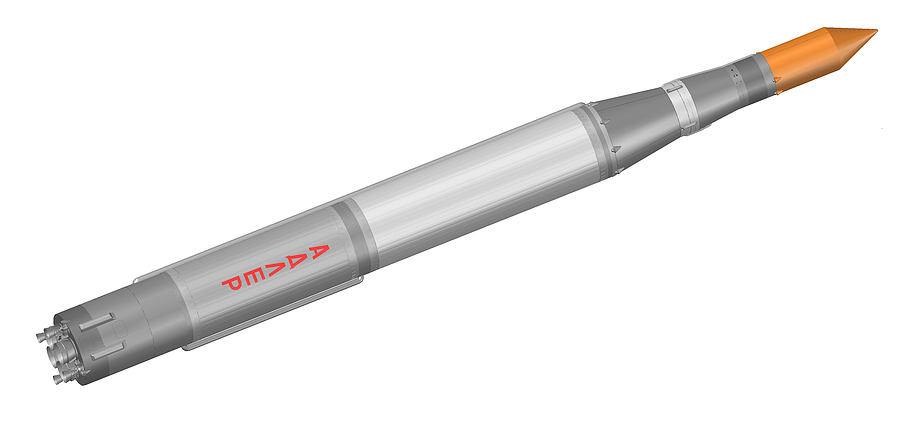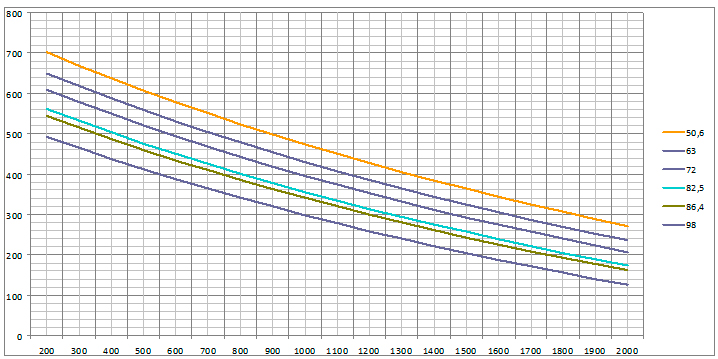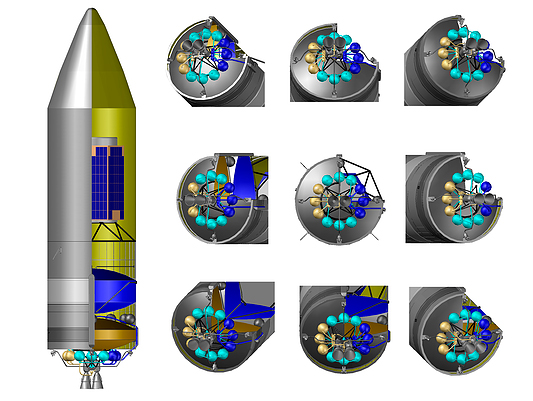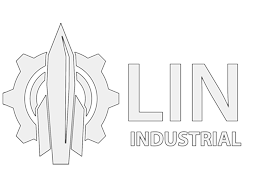Adler smallsat launch vehicle

The project of Adler two-stage space launch vehicle (LV) with payload of 700 kg (version 2 — 1000 kg), powered by environmentally safe propellants, was positively assessed by the experts from the Space Technologies and Telecommunications Cluster of the Skolkovo Foundation.
Simple and cost efficient technical solutions are to be applied for the creation of the launch vehicle.
- Gross mass — 60 metric tons.
- Payload — 700 kg to low Earth orbit (LEO).
- 1st stage (diameter — 2.4 m) — RD-108A engine.
- 2nd stage (diameter — 1.86 m) — engine based on RD-108A main chamber.
- Propellant tanks — smooth-walled, made of AMg6 aluminium-magnesium alloy.
- Height with payload fairing — 28.1 m.
Why a smallsat launch vehicle?
The project is aimed at reducing costs of launch to LEO for microsats and nanosats.
The last decade has seen a trend of shifting from heavy satellites weighing multiple tons to satellites in micro- and nano- classes.
The development of microsat (10–100 kg), smallsat (100–500 kg) and nanosat (1–10 kg) platforms is seen around the world. Both private and state-owned companies and educational institutions are involved in the creation of such satellites. Russian private companies Dauria Aerospace and SPUTNIX also plan to launch microsats and nanosats.
- New Russian Soyuz-2-1v launch vehicle with payload of 2800 kg.
- Rockot launch vehicle (converted ICBM) with payload of 2300 kg.
- Dnepr launch vehicle (converted ICBM) with payload of 3700 kg.
- Strela launch vehicle (converted ICBM) with payload of 1700 kg.
- New Russian Angara-1.2 launch vehicle with payload of 3800 kg.
Note that payloads of these launch vehicles are excessive for launching individual microsats and nanosats, resulting in the need for cluster launches. This practice is inconvenient for customers having individual satellites.
There is growing need for the creation of a relatively cheap microsat launch vehicle specifically for such spacecraft.
Currently many countries and private companies are working in this area, yet none of them has relatively cheap smallsat launch vehicle.
When using medium-lift launch vehicles to launch microsats and nanosats as secondary payloads, the primary payload preparation schedule slips sometimes, resulting in launch delays for the secondary payloads. Adherence to a launch schedule is particularly critical when deploying orbital constellations of multiple spacecraft.
The proposed project solves the problem of short lead time and convenience for microsat and nanosat launches.
Small satellite launches in the USA
- Planetary Resources company announced signing a contract with Virgin Galactic for launch of four Arkyd-100 commercial space telescopes to study asteroids.
- Skybox Imaging company from California paid $91 mln to launch at least two remote sensing satellites.
- GeoOptics Inc. company from California wants to use a small-lift launch vehicle to deploy a satellite of spacecraft in orbit for environmental monitoring.
- Spaceflight Industries private aerospace corporation from Seattle plans to use LauncherOne to launch various payloads weighing from 1 to 300 kg.
The problem with launches of small satellites abroad is their high price (above $15 mln) for launch.
High costs of smallsat launch vehicle development are also notable.
Today the problem of high costs of space launches is one of the hurdles in the path of microsat and nanosat technology development.
Innovation of the approach to Adler launch vehicle design
The project solves the problem of reducing costs of space launch for small spacecraft by creating a new smallsat launch vehicle using mass-produced rocket engine on the first stage, and main chamber of engine of the same type on the second stage, and simple technological solutions, including vehicle assembly by civilian manufacturer.
-
We widely use proven technological solutions - currently manufactured rocket engine for the first stage, and proven main chamber as a basis for the second stage engine. The first stage features RD-108A engine (used on the central core of Soyuz launch vehicle).
The second stage features an engine based on RD-108A main chamber and a nozzle extension made of carbon-fiber-reinforced polymer. - Specialized ignition system is proposed for use on the 2-nd stage engine. An option of using a laser ignition system developed by Spectralaser, a Skolkovo resident, is being considered.
-
Technologically simple structural solutions are used for the launch vehicle.
For example, a possibility is considered for manufacturing the propellant tanks for the vehicle by a civilian enterprise outside the space industry.
Preliminary talks were held with the management of OJSC Kalibrovsky Zavod, agreement is reached. -
The basis of the project is optimization for launch costs and launch vehicle return on investment, rather than increasing payload fraction.
Taking into account the fact that the fraction of propellant cost is relatively small as compared to the cost of the launch vehicle (about 4-5%), we expect to create a launch vehicle meeting the desired specifications not by complicating the design (by using additional stages and space tugs), but due to simplifying it — reducing the number of stages to two and slightly increasing the mass of propellants.
Reusability
One of the innovation approach components is the creation of a launch vehicle, which can be reused.
In the future implementation of the recovery of the first stage or powerplant is possible:
1-st phase. Solutions applied to the launch vehicle will allow to implement reusability:
- reducing weight of the launch vehicle first stage;
- structural components of the first stage can be used as elements of the recovery system - design of the interstage includes four deployable drag brakes, which will be used for aerodynamic stabilization and braking of the first stage during its descent to the ground.
2-nd phase. Plans include testing of the first stage recovery involving a combination of parachute, rocket descent engines and inflatable airbags.
3-rd phase. Testing of the second stage engine recovery is planned (and later the entire stage recovery) employing inflatable conical decelerator, being developed by NPO Lavochkin.
Partial reusability will not require significant engine refinement, since the first and second stage engines have lifetime exceeding the time of a single burn during launch.
In general, innovation of the approach is in significant streamlining of the end product and outfitting the LV with means of recovery, allowing to reuse some of its components, thus reducing the launch costs for spacecraft.
Trends in the subject area
- First stage reusability. American company SpaceX works on launch vehicle reusability. Despite the fact that no part of launch vehicle could be recovered and reused yet, work goes on.
- Demand for small-lift launch vehicles is growing due to reducing spacecraft mass.
-
The following projects of small-lift launch vehicles exist in Russia:
- MRKS, a reusable launch system. Khrunichev Space Center proposed Baikal reusable flyback booster-derived first stage, developed by Khrunichev Space Center in partnership with NPO Molniya on their own initiative. The booster itself can be used with Angara family being tested today.
- Tu-160SK based aerospace system (Burlak-Diana). Burlak launch vehicle is developed by Raduga Design Bureau. Estimated cost of preliminary works is at least $160 mln. Cost per launch is $2.5 mln. Cost per 1 kg in orbit is $6000-$8000.
- Air Launch aerospace project involves An-124-100 "Ruslan" strategic airlifter and Polyot two-stage launch vehicle (powered by liquid oxygen and kerosene). For the first stage, NK-43 (NK-33-1) liquid-propellant engine is expected, its production can be resumed. The third stage of Soyuz-2 launch vehicle with RD-0124 engine is used as the 2-nd stage of Polyot launch vehicle.
- Diana two-stage launch vehicle project, developed by RSC Energia in 1997 based on Soyuz launch vehicle components. According to technical documents, Diana with launch weight of 65 metric tons could launch payloads up to 0.95 metric tons to LEO (200 km) when launched from Baikonur cosmodrome.
- Ishim aerospace project. Three-stage solid-propellant launch vehicle was expected to start from 15-18 km altitude at the speed of 2200 km/h (1367 mph) from MiG-31I aircraft. Payload is 160 kg when launched to 300 km circular orbit, or 120 kg when launched to 600 km orbit. At the same time launch costs are within $3000-$6000 per kg.
-
Introduction of small-lift launch vehicles abroad, like:
- Falcon 1 launch vehicle by SpaceX company with payload of 670 kg to LEO. Currently the vehicle was launched 5 times, with 2 successful launches and 3 failures. The operation ceased in favor of Falcon 9 heavy launch vehicle.
- LauncherOne launch vehicle project by American company Virgin Galactic with payload of 225 kg to LEO. The project was announced in 2012, with real launches planned after 2016.
- Pegasus launch vehicle by American company Orbital Sciences Corporation with payload of 443 kg to LEO. 37 launches are successful out of 42.
- Vega launch vehicle by European Space Agency with payload of 2000 kg to LEO. Note that the launch vehicle is solid-propellant and uses highly toxic propellants on its upper stage. Two launches were made, both successful.
- Epsilon launch vehicle (ASR) by Japan Aerospace Exploration Agency with payload of 1200 kg to LEO, it is also a solid-propellant vehicle with highly toxic propellants. The only launch was successfully completed on September 14, 2013.
- Utmost streamlining of ground services — automonous navigation, digital control systems, reducing of the launch staff.
- The market trend is providing launch services for companies with small spacecraft, as requested. The advent of private companies in the space sector marked the transition from increasing the payload fraction at all costs to optimization of launch costs, as well as launch vehicle creation and operation costs.
Basic technology description
The project is based on mass-produced and highly reliable rocket engine and streamlined technological solutions.
The choice of the first stage diameter (2.4 m) was made while taking into account that today the Ministry of Defence has preserved equipment for the maintenance of Kosmos-3M launch vehicle with the same diameter.
RD-108A engine is expected for use on the first stage of the launch vehicle. This is a liquid-propellant rocket engine with four vernier chambers, using environmentally safe propellants — oxygen and kerosene. This engine is mass-produced since 1957 and proved its reliability.
The first stage has necessary elements for implementing stage recovery, such as four deployable drag brakes for stabilization and braking of the first stage during its descent to the ground.
Testing of the first stage recovery is planned at NII Geodeziya test range — preliminary negotiations are completed. The first stage recovery system will include a combination of parachute, rocket descent engines and inflatable airbags.
An engine based on RD-108A main chamber with pressure-fed design and carbon-fiber-reinforced polymer nozzle extension are to be used on the second stage.
Special ignition system is to be used for the second stage engine. An option of using a laser ignition system developed by Spectralaser, a Skolkovo resident, is being considered.
The use of this ignition system allows to perform multiple burns of the second stage engine, placing payloads into elliptical orbits and performing various orbit-raising maneuvers.
For the second stage engine recovery (and later the entire second stage) a modified inflatable conical decelerator (PTU) by NPO Lavochkin is expected to be used. Computing of the aerodynamics of the engine return is based on the vortex lattice method. The design of the second stage engine recovery will be considered in detail in the subsequent phases of the project.
Recovery system mockups are to be installed on the vehicle for the early flights. Its gradual introduction will occur after commissioning the launch vehicle.
- Use of a small hypersonic drogue parachute to slow the first stage right after its separation from the launch vehicle. This innovation, not used before, allows to bring the impact site closer to the launch site, and later shorten the distance between the landing site and the cosmodrome.
- Use of gas thrusters with dedicated gas generator powered by the remaining propellants for attitude control during descent and landing. This allows to reduce the area of probable impact (landing) of the stage.
- Use of embedded beacons and a parachute system allows to find the stage at high altitudes in the atmosphere in order to intercept it with a helicopter (Mi-26) prior to landing. In this case the stage can be reused after a brief period of time. This significantly reduces the total launch cost.
Negotiations are planned for obtaining the launch vehicle control systems from Mars Design Bureau state-owned enterprise.
We expect to refuse of traditional milled tanks in the project due to manufacturing complexity. Smooth-walled strengthened shells are to be used instead.
Transportation
Engineering solutions incorporated in the launch vehicle design allow to move it by any means of transport — such as aircraft, trains and trucks.
- railroad — loads while moving a freight car on jointed track, shock load;
- aircraft — landing shock;
- truck — loads while accelerating and braking.
An option of launching from an unprepared site within 3 days after launch equipment delivery is considered for the later phases of the project. In the first phase launches are possible from Kapustin Yar launch site.
Technical description of Adler launch vehicle
Adler launch vehicle consists of two rocket modules with tandem staging design. All stages feature liquid-propellant rocket engines powered by environmentally safe propellants: oxidizer — liquid oxygen, fuel — kerosene.
The rocket module of the first stage consists of interstage, oxidizer tank, instrumentation module, fuel tank and tail section. The tanks for oxidizer and fuel are cylindrical, smooth-walled, made of AMg6 aluminium-magnesium alloy. The tail section includes liquid nitrogen tank, hydrogen peroxide tank and the main engine. RD-108A engine is implemented with open cycle design with gas generator powered by hydrogen peroxide. Oxidizer tank pressurization is performed by gaseous oxygen, fuel tank pressurization is performed by gaseous nitrogen.
Flight control of the first stage for all three axes is performed by vernier thrusters of the main engine.
Rocket module of the second stage consists of instrumentation module, oxidizer tank, intertank section, fuel tank and tail section. The tanks for oxidizer and fuel are suspended, have spherical shape, and made of AMg6 aluminium-magnesium alloy. The intertank and tail sections are conical. The tail section includes the main engine, based on the main chamber of mass-produced RD-108A engine with pressure-fed design and reinforced-carbon-fiber polymer nozzle extension. Special ignition system is to be used for the second stage engine. An option of using a laser ignition system developed by Spectralaser, a Skolkovo resident, is being considered.
Control for yaw, roll and pitch axes is performed by four vernier thrusters powered by pressurizing gas.
Stage separation is 'cold' and involves explosive bolts.

Adler performance chart

Vertical axis — payload launched into orbit. Horizontal axis — altitude of target circular orbit. Orbital inclinations: 50.6 degrees — Kapustin Yar launch site, 63, 72, 82.5, 86.4, 98 degrees — Baikonur Cosmodrome.

The main path of commercialization is providing launch services with competitive price. Potential customers are domestic civil and military users, as well as customers from abroad.
Costs and profits estimation
Cost of one launch vehicle is $3 mln including cost of the 1st stage rocket engine ($1 mln), the 2nd stage rocket engine ($0.3 mln), rocket structural system ($0.7 mln).
Launch preparation cost — $1 mln
Launch cost — $4 mln
Cost for payload in orbit — ~$5750 per kg
Costs for the launch vehicle creation + ground testing:
17 * $3 mln = $51 mln
Number of commercial launches per year — 3
Price per launch — $10 mln
Price per 1 kg in orbit — $14,285
Profit per launch — $6 mln
The project's rate of return

Vertical axis — millions of USD, horizontal axis — launches. Colors — costs, $; profit, $.
Therefore, after 4 years and 14 launches the project reaches the break-even point and becomes profitable.
Adler-2 launch vehicle with payload of 1000 kg

Technical description of Adler-2 launch vehicle
Adler-2 launch vehicle consists of two rocket modules with tandem staging design. All stages feature liquid-propellant rocket engines powered by environmentally safe propellants: oxidizer — liquid oxygen, fuel — kerosene.
The rocket module of the first stage consists of interstage, oxidizer tank, instrumentation module, fuel tank and tail section. The tanks for oxidizer and fuel are cylindrical, smooth-walled, made of AMg6 aluminium-magnesium alloy. The tail section includes liquid nitrogen tank, hydrogen peroxide tank and the main engine. RD-108A engine is implemented with open cycle design with gas generator powered by hydrogen peroxide. Oxidizer tank pressurization is performed by gaseous oxygen, fuel tank pressurization is performed by gaseous nitrogen.
Flight control of the first stage for all three axes is performed by vernier thrusters of the main engine.
Rocket module of the second stage consists of instrumentation module, oxidizer tank, intertank section, fuel tank and tail section. The tanks for oxidizer and fuel are cylindrical, smooth-walled and made of AMg6 aluminium-magnesium alloy. The tail section includes the main engine, based on two vernier thrusters of RD-108A, and liquid nitrogen tanks for pressurization and support of pneumatic pump operation for feeding the propellants. Special ignition system is to be used for the second stage engine. An option of using a laser ignition system developed by Spectralaser, a Skolkovo resident, is being considered. The use of this ignition system allows to perform multiple burns of the second stage engine, placing payloads into elliptical orbits and performing various orbit-raising maneuvers.
Control for yaw, roll and pitch axes is performed by four vernier thrusters powered by pressurizing gas.
Stage separation is 'cold' and involves explosive bolts.
Pneumatic pump
The Adler second stage uses pneumatic pump of our own design.
3D model of pneumatic pump on the second stage

Costs and profits estimation
Cost of one launch vehicle is $3 mln including cost of the 1st stage rocket engine ($1 mln), the 2nd stage rocket engine ($0.3 mln), rocket structural system ($0.7 mln).
Launch preparation cost — $1 mln
Launch cost — $4 mln
Cost for payload in orbit — ~$4000 per kg
Costs for the launch vehicle creation + ground testing:
20 * $3 mln = $60 mln
Number of commercial launches per year — 3
Price per launch — $14 mln
Price per 1 kg in orbit — $14,000
Profit per launch — $10 mln
The project's rate of return

Vertical axis — millions of USD, horizontal axis — launches. Colors — costs, $; profit, $.
Therefore, after 2 years and 8 launches the project reaches the break-even point and becomes profitable.
Promising markets for the project
Domestic market — launching government payloads for military and civil applications, and spacecraft of privately-owned companies like Dauria Aerospace, SPUTNIX and others. Besides, satellites of students, academic institutions, experimental satellites of scientific research organizations.
Since the trend of shrinking the mass of spacecraft is common across the globe, foreign customers can be expected.
The market for smallsat launch vehicles is estimated at $0.5-$1 bln/year, that is about 15-20 launches. The market is actively growing, 2013 has seen 22 successful launches and 102 spacecraft delivered to their orbits, that is half the number of spacecraft delivered to orbits in that year. 60% of the satellites launched by smallsat launch vehicles are based on CubeSat nanosatellite platform.
With launch rate of 3 launches per year the development and manufacturing of the launch vehicles reaches break-even point in 3 years. This implies launching 3–4 minisats and providing shared rides for some dozens of micro- and nanosatellites, that's approximately 5–10 % share of the worldwide market for smallsat launch vehicles.
History and evolution of the project
September 2013 — A concept was proposed.
October 2013 — Preliminary talks were held with the project consultants. Key specifications of the launch vehicle and engine type were chosen.
November 2013 — Preliminary research was carried out, range of payload to orbit, orbit inclination and altitude were refined after mathematical modeling. Feasibility parameters were determined: manufacturing cost per launch vehicle, launch cost, total cost of development and payback period.
December 2013 — Preliminary design studies were held, parameters of the launch vehicle were refined, we actively look for an investor.
January-March 2014 — Necessary changes were applied to the configuration, technical requirements were documented, negotiations on possible cooperation were held with OJSC Kalibrovsky Zavod.
Current status of the project
General outline of the launch vehicle is complete; key specifications, payload and possible target orbits are determined. Rough estimation of manufacturing costs is made. Preliminary negotiations were held with component manufacturers.
